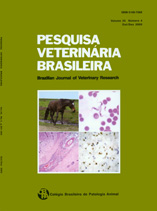 |
|
|
|
Year 2005 - Volume 25, Number 4
|

|
Experimentally induced intravaginal Tritrichomonas foetus infection in a mouse model, p.225-230
|
Soto P., Echevarría H.M., Monteavaro C.E. & Catena M.C. 2005. Experimentally induced intravaginal Tritrichomonas foetus infection in a mouse model. Pesquisa Veterinária Brasileira 25(4):225-230. Laboratory of Clinical and Experimental Microbiology, Facultad de Ciencias Veterinarias, UNCPBA, Pinto 399, Tandil (7000), Buenos Aires, Argentina. E-mail: psoto@vet.unicen.ar
The interest to develop research on the host-parasite relationship in bovine tritrichomonosis has accomplished the use of experimental models alternative to cattle. The BALB/c mouse became the most appropriate species susceptible to vaginal Tritrichomonas foetus infection requiring previous estrogenization. For the need of an experimental model without persistent estrogenization and with normal estrous cycles, the establishment and persistence of vaginal infection on BALB/c mouse with different concentrations of T. foetus in two experimental groups was evaluated. Group A was treated with 5mg of b-estradiol 3-benzoate to synchronize the estrous, 48 hours before the T. foetus vaginal inoculation, and Group B was inoculated in natural estrus. At 5-7 days after treatment, estrogenic effect decreased allowing all animals to cycle regularly during the experiment. From the first week post-infection, samples of vaginal mucus were taken from all animals during 34 weeks, in order to evaluate the course of infection and the stage of the estrus cycle. Group A showed 93.6% of infected animals, and Group B showed 38%. Different doses of T. foetus were assayed to establish the vaginal infection, with a persistence of 34 weeks. Although different behavior was observed in each subgroup belonging to either Group A or Group B, there were no significant differences among the infecting doses used. The b-estradiol 3-benzoate treatment had a favorable effect on the establishment of the infection (P<0.0001), but it did not influence its persistence (P=0.1097). According to the results, an experimental mouse model is presented, appropriate for further studies on mechanisms of pathogenicity, immune response, protective evaluation of immunogen and therapeutic effect of drugs. |
| |
|
|
| |
|
 |